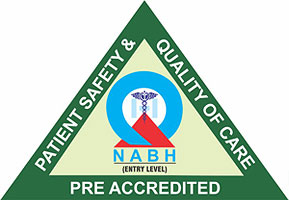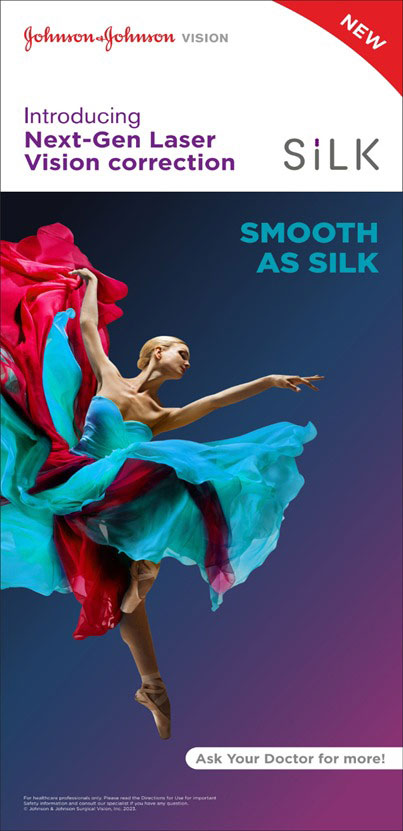+91-9240214610 (Bandra)
+91-9240214611 (Kandivali)




Ojas Eye Hospital has been at the forefront of refractive error correction procedures in India since the last 34 years. In 2011, we were the first eye hospital in Mumbai and Western India to start INTRALASE Bladefree Lasik Laser Vision Correction treatment. This revolutionary procedure allowed patients to get complete freedom from spectacles and contact lenses.
In 2017, Ojas Eye Hospital was one of the first few eye hospitals in India to adopt the Contoura Vision technology with Bladeless Femtolasik and today is a strong leader in refractive error correction procedures.
Keeping in line with our principle of providing our esteemed patients the latest and best in class medical technology, Ojas Eye Hospital is proud to announce that we are the first eye hospital in Western India to bring the next generation of laser vision correction solution, the ELITA Femtosecond Laser to our Bandra West branch in Mumbai, India.
Johnson & Johnson Vision, a global leader in eye health has launched thisnext-generation laser vision correction solution, the ELITA Platform in 2023 at the 41st European Society of Cataract and Refractive Surgeons (ESCRS) congress. With the ELITA platform, our surgeons are able to offer patients with myopia, with or without astigmatism, refractive vision correction using the new SILK (Smooth Incision Lenticule Keratomileusis) procedure. The ELITA Femtosecond laser uses an ultra precise laser pulse having the fastest laser delivery system, allowing for a consistently smooth and easy lenticular removal.
While older platforms such as SMILE (2012) and CLEAR (2019) use similar processes as The ELITA Femtosecond platform to perform lenticule extraction, the SILK procedure has significant improvements over the other procedures which truly make it the next-generation technology in refraction error correction.
SILK stands for Smooth Incision Lenticule Keratomileusis. SILK is the newest and most advanced technology introduced in 2023 by Johnson & Johnson Vision for correcting vision problems. It is an innovative eye surgery technique which uses a very high-tech laser platform called ELITA to fix eye problems like near-sightedness (ie myopia) and astigmatism. The procedure is based on lenticule extraction, making it flap-less, blade-free and quick recovery time.

ELITA SILK Eye Surgery is laser surgery platform launched by Johnson & Johnson Vision which uses a very advanced femtosecond laser to perform the smooth lenticule extraction. The ELITA laser helps correct vision issues like near-sightedness (myopia) and astigmatism.
In addition, Johnson & Johnson Vision has already received US FDA approval for the ELITA Femtosecond Laser. We are excited to add the ELITA Femtosecond laser and the SILK procedure to our list of advanced procedures offered to patients looking for freedom from their spectacles and contact lenses. To know more about the procedure and book your appointment, reach out to us over email at info@ojaseyehospital.com or call us on +91 91374 62795 / +91 98192 30290

SILK stands for Smooth Incision Lenticule Keratomileusis. It is the next generation eye care surgery technique for refractive error correction developed by Johnson & Johnson Vision USA. The innovative and advanced technique is a flap-less, blade-free technique which focuses on creating a smooth cornea surface through lenticule extraction. By utilizing cutting-edge technology, this minimally invasive procedure involves creating a tiny disc-shaped lens (ie lenticule), within the cornea. This lenticule is then delicately removed through a microscopic incision, reshaping the cornea to provide patients with clearer, sharper and flawless vision. Because the procedure does not involve creation of a flap, recovery time in this procedure is as fast as 24 hours.
ELITA is the next-generation Femtosecond Laser Platform launched by Johnson & Johnson Vision USA in 2023 at the 41st European Society of Cataract and Refractive Surgeons (ESCRS) congress held in Vienna, Austria. Using the ELITA Femtosecond Platform, our expert eye doctors at Ojas Eye Hospital are able to perform advanced refractive error correction SILK procedure on patients with myopia (near-sightedness), with or without astigmatism.
The ELITA Femtosecond Laser platform provides our surgeons with an ultra-precise, low energy (60 nano Joule per pulse energy) and superfast (150 femtoseconds pulse duration) laser pulse delivery system, through which the surgeon is able to perform a smooth, easy and thorough lenticule extraction, offering our esteemed patients exceptional vision correction with a 24 hour recovery and next day results.
Patients with myopia (near-sightedness), with or without astigmatism can potentially opt for SILK Procedure to get freedom from their prescription glasses or contact lenses. In most cases, 24 hours post the SILK procedure, patients can expect clear and sharp vision as well as enhanced vision.
The SILK Procedure is particularly effective in correcting near-sightedness (myopia) and astigmatism. It can significantly improve visual acuity for individuals experiencing these common vision issues.
The ELITA Femtosecond laser launched by Johnson & Johnson Vision, a global leader in eye care and eye health which is a part of Johnson & Johnson MedTech USA has received FDA clearance. In addition, it has also received CE Mark approval. The ELITA SiLK procedure is a very advanced and safe procedure for vision correction.
However, like any medical procedure, there are potential risks and individual suitability factors to consider. It's important to consult with a qualified eye surgeon who can assess your specific circumstances and determine if SILK is the right choice for you.
The recovery time after SILK Procedure is often swift. Many patients can return to their regular activities within 24 hours. You may experience some mild discomfort, but this is typically temporary. To ensure a smooth recovery, it's crucial to follow the post-operative instructions provided by your doctor and attend follow-up appointments.
Typically, candidates for SILK Procedure should be at least 22 years old. The procedure is often suitable for a wide age range, but eligibility can be influenced by individual factors, which your eye surgeon will evaluate.
Yes, the SILK Procedure can be performed on both eyes during the same session. This approach is common and can provide patients with the convenience of improved vision in both eyes simultaneously.
The coverage of SILK Procedure by insurance or flexible spending accounts (FSAs) varies depending on your specific plan and provider. It is advisable to check with your insurance company or FSA administrator to determine if this procedure is eligible for coverage.
The SILK Procedure is known for its efficiency, typically taking approximately 20 minutes to complete. This quick process is facilitated by advanced laser technology.
In some cases, SILK Procedure may be reversible. However, the decision to reverse the procedure would depend on your individual circumstances and should be discussed with your eye surgeon.
Individuals with a history of dry eyes may still be candidates for the SILK Procedure. Your eye surgeon will evaluate your specific condition and provide guidance on the best course of action to ensure a successful outcome.
Yes, you can typically resume using eye makeup after the SILK Procedure. It's important to follow your doctor's guidance regarding the use of cosmetics following the procedure to avoid any potential complications.
Many patients can resume using digital devices, such as smartphones and computers, shortly after the SILK Procedure. It's important to follow your doctor's recommendations for screen time and eye care.
To ensure a smooth recovery, it is advisable to avoid strenuous physical activities for a few days after the SILK Procedure. Your doctor will provide specific guidelines based on your condition.
In most cases, there are no significant restrictions on driving after the SILK Procedure. Many patients can resume driving shortly after the surgery. However, it's essential to consult your surgeon for personalized advice based on your condition.
It's generally recommended to avoid swimming or participating in water-related activities for a brief period after the SILK Procedure. Your eye surgeon will provide specific guidance on when it's safe to resume these activities.
The use of contact lenses after the SILK Procedure may be possible, but it is essential to discuss this with your eye surgeon. They can provide recommendations based on your individual situation.
SILK Procedure can provide long-lasting vision improvements. However, it is essential to attend regular follow-up appointments to monitor the stability of your vision and address any changes that may occur over time.
Most patients experience significant vision improvement within a few days following the SILK Procedure. However, final results may continue to refine over several weeks.
Some patients may experience temporary sensitivity to bright lights after the SILK Procedure. Using sunglasses or avoiding direct exposure to intense light sources can help manage this sensitivity.
Yes, the SILK Procedure is effective in correcting astigmatism, providing improved vision for individuals with this common refractive error.
In some cases, the SILK Procedure can be combined with other vision correction treatments to address specific visual issues. Your eye surgeon can assess the suitability of combination treatments for your unique needs.
The cost of SILK Procedure may vary depending on factors such as your location and the specific details of your treatment plan. It's recommended to contact your chosen eye care center for information on procedure costs.
To determine if you are a candidate for the SILK Procedure, it is essential to consult with an eye surgeon. They will conduct a comprehensive evaluation of your eye health, visual needs, and medical history to assess your eligibility.
Following SILK Procedure, there may be specific guidelines on makeup use to ensure a smooth and complication-free recovery. It is advisable to adhere to your doctor's instructions.
SILK Procedure results can be stable, but individualexperiences may vary. Regular eye check-ups are recommended to monitor your vision's stability and address any changes that may occur over time.
Yes, SILK Procedure can effectively correct significant astigmatism, providing improved visual outcomes for individuals with high astigmatism levels.
The stability of your vision after SILK Procedure can vary from person to person. In many cases, the vision remains stable for an extended period, but it's important to have regular eye check-ups to assess any changes.
In most cases, there are no significant restrictions on screen time after the SILK Procedure. Many patients can use digital devices shortly after the surgery. However, it's advisable to follow your doctor's recommendations.
The SILK Procedure is capable of correcting significant astigmatism, including levels of astigmatism up to 6D. It provides an effective solution for individuals with such refractive errors.
Engaging in contact sports should be avoided initially after the SILK Procedure. It is important to consult with your eye surgeon and follow their recommendations for a safe return to sports and physical activities.
SILK Procedure is generally not considered painful. Patients may experience some discomfort, but it is typically mild and temporary. Your surgeon will provide guidance on managing any discomfort.
In certain situations, other vision correction procedures like LASIK, Contoura Vision, or PRK may be possible after the SILK Procedure. Your eye surgeon can assess your specific needs and determine the most suitable course of action.
SILK Procedure distinguishes itself through its use of advanced laser technology, which allows for quicker recovery, enhanced comfort, and precise vision correction. It offers an efficient and effective approach to improving vision.
Preparing for the SILK Procedure typically involves following your surgeon's pre-operative instructions. This may include discontinuing contact lens use, adjusting medications, and other specific guidelines tailored to your needs.
Many patients can resume using their mobile phones as soon as the day after the SILK Procedure. It's essential to follow your doctor's recommendations for screen time and eye care.
Following the SILK Procedure, it is advisable to adhere to your doctor's post-operative precautions to ensure a smooth recovery. These may include avoiding strenuous activities, applying prescribed eye drops, and using protective eye shields when sleeping.
Insurance coverage for the SILK Procedure can vary depending on your specific insurance plan and provider. To determine eligibility for coverage, it is recommended to contact your insurance company for detailed information.
Many patients who undergo the SILK Procedure achieve 20/20 vision or even better. The actual outcome can depend on various factors, including your initial vision prescription and individual response to the procedure.
If you experience discomfort after the SILK Procedure, it is essential to contact your doctor. They can provide guidance and recommend appropriate measures to address any discomfort or pain.
The possibility of having additional eye surgeries after the SILK Procedure can vary based on individual circumstances. Consulting with your eye specialist is necessary to determine if other procedures are suitable for your specific needs.
The recovery time after the SILK Procedure is often swift, with most patients able to return to work and their regular activities within approximately 24 hours. However, individual experiences may vary.
The feasibility of undergoing the SILK Procedure with a history of eye surgeries depends on the specifics of your previous surgeries and your current eye health. Consult with your eye surgeon to assess your eligibility.
Having a history of eye infections or inflammations may influence your eligibility for the SILK Procedure. It's essential to consult with your eye surgeon to determine if the procedure is safe for you.
The presence of diabetes may affect your suitability for the SILK Procedure. It is crucial to discuss your diabetic condition with your eye specialist, who can assess the risks and benefits of the procedure in your case.
To ensure a smooth recovery, it's important to follow your doctor's guidance regarding the use of makeup or cosmetics. In many cases, you can typically resume using makeup shortly after the procedure.
The SILK Procedure is primarily designed to correct nearsightedness and astigmatism, and it may not directly address presbyopia. Individuals with presbyopia may explore alternative treatment options with their eye surgeon.
In general, there are no specific dietary restrictions associated with the SILK Procedure. However, it is advisable to maintain a balanced diet for overall health and well-being.
The SILK Procedure is typically recommended for individuals who are at least 22 years old. It may not be suitable for children or teenagers, and alternative treatments may be considered.
There are typically no specific restrictions on alcohol consumption related to the SILK Procedure. However, it is advisable to follow your doctor's pre-operative and post-operative instructions for the best results.
A family history of glaucoma may be considered during your evaluation for the SILK Procedure. Your eye surgeon will assess your individual risk factors and determine the appropriateness of the procedure.
Some patients may experience temporary discomfort or dryness in their eyes after the SILK Procedure. This can vary from person to person, but these symptoms typically resolve within a few days or weeks.
The SILK Procedure can effectively correct high levels of myopia and astigmatism in many cases. However, the suitability of the procedure will depend on individual factors and your eye surgeon's evaluation.
If you experience eye allergies after the SILK Procedure, it's important to follow your doctor's advice for managing them. This may include the use of prescribed eye drops or other measures.
You can typically resume outdoor sports and activities after the SILK Procedure. It's important to wear appropriate eye protection, such as sunglasses, to shield your eyes from potential irritants.
Flying on an airplane shortly after the SILK Procedure is generally safe. However, it's a good idea to follow your doctor's guidance and use lubricating eye drops during the flight to prevent dryness.
The SILK Procedure primarily addresses nearsightedness and astigmatism. Vision issues related to aging or hormonal changes may require different treatments or approaches.
A history of retinal detachment may influence your eligibility for the SILK Procedure. Consult with your eye surgeon to assess the risks and benefits in your specific case.
To maintain the long-term stability of your vision after the SILK Procedure, it's important to attend regular eye check-ups as recommended by your doctor. They can monitor your eye health and address any changes that may occur over time.

With the growing age and multiple times facing the problems of blurred vision, the need of doing an eye check up did arouse. I visited Ojas Eye hospital for the tests and soon I was diagnosed with the eye disease called Cataract. My mind was baffled with questions. Friendly approach of Dr.Dedhia, in Pre and post operations, was truly supporting. The advanced eye correction equipment did ensure the rest. My cataract operation is successful and at present I am blessed with clear vision.

DEAR DOCTOR DEDHIA & ALL AT LASER EYE CENTER ;
It is been a wonderful experience to know you all and also to be treated by such a friendly and excellent team of professionals. What you all have done for me is just inexplicable all can say is "Thank you so much" for doing this wonder on my eyes. It really feels great to have an aid less vision. May God bless all of you all health and happiness and wish you all the very best for your work!
Dr. Nitin Dedhia is my family's eye specialist since long time. My grandmoms cataract surgery was done by him around 20 years ago. She is still having very good eyesight at 90. I too have have done my lasic around a week ago and now able to see everything without specs. Would like to advice Dr Dedhia Sir for any of your complaints regarding eyes. The all staff are well trained and cooperative. Good infrastructure too. would thank everyone there.
It was a good experience with Dr. Dedia. He is very particular about cleanliness which I liked. The staff too were quick and courteous.I am also impressed with Dr. Hardik who has explained to me in detail. And Greta too is a very efficient receptionist. Thank you all the staff for not keeping me waiting.